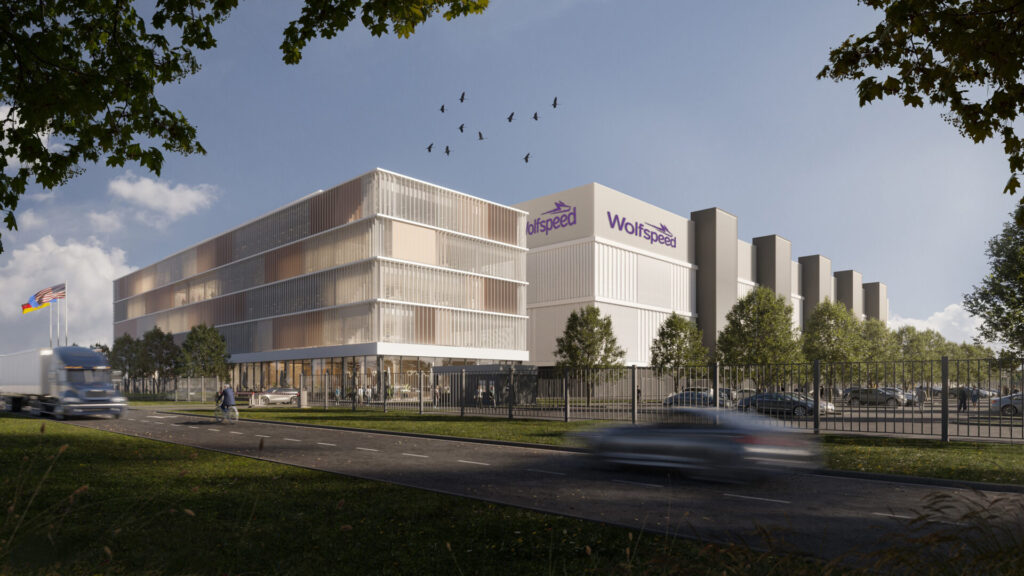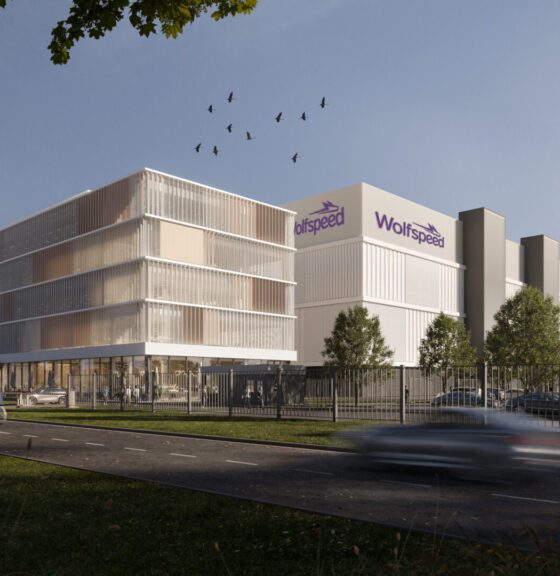An upcoming EV chip manufacturing plant in Germany is poised to finally tackle the chip shortage that has ravaged automakers worldwide.
If one thing has become eminently clear over the past three years, it is the fact that the supply chains that bring us everything from cars to surgical masks are incredibly delicate and, further, can benefit from numerous points of origin. Perhaps nowhere has this been seen better than in the scramble for automotive computer chips in the wake of COVID-19 across the world in 2020. Now, according to a press release from German chip conglomerate ZF Friedrichshafen (ZF) and American chip maker Wolfspeed, the two will be collaborating to meet this demand with a new chip fabrication plant in Germany.
The company itself confirmed the plant this morning. The upcoming factory “will be the world’s largest, utilizing innovative manufacturing processes to produce next-generation Silicon Carbide devices.” But the importance of the factory isn’t just due to its potential to meet the near overwhelming demand of automakers for EV computer chips, but in its strategic location.
Saarland, a German state located on the border with France, will reportedly be the home of the upcoming fabrication location. From there, Wolfspeed and ZF would be able to quickly and efficiently meet the demand for EV chips of Porsche in Stuttgart, BMW in Bavaria, and Mercedes in central Germany. Further, it would also be able to meet upcoming demand from Renault and Stellantis just over the border in France.
Even outside of that immediate radius, Tesla’s massive Giga-Berlin facility and Ford’s numerous production locations found in Northern Germany can benefit from this new supply.
Hier in Ensdorf im Saarland, wo einst Kohle verstromt wurde, entstehen mit der neuen Fertigungsanlage viele Arbeitsplätze und effiziente Halbleiter. Wir brauchen sie für E-Autos, Erneuerbare Energien, für die #Transformation. Wolfspeed und ZF stärken so den Wirtschaftsstandort ?? pic.twitter.com/tEt7jvPsus
— Bundeskanzler Olaf Scholz (@Bundeskanzler) February 1, 2023
Neither a production start date nor an estimate of production capacity have been announced, though construction will begin in the first half of this year, pending confirmation from the European Unions. The upcoming plant will supposedly cost €3 billion ($3.27 billion), with ZF holding a minority in the venture. This is part of Wolfspeed’s previously announced $6.5 billion global expansion plan, which included two other production locations in the United States.
German officials also see the new project as a win, one telling Reuters, “Amid the concerns that the U.S. wants to divert investments from Europe with its Inflation Reduction Act, we’re showing that a U.S. firm wants to invest in Germany.” However, it should be noted that Wolfspeed and ZF are likely attracted to Germany following the success of Europe’s own “IRA,” which plans to invest 45 billion euros ($49.03 billion) into computer chip manufacturing throughout the continent. The plan has yet to be finalized by the European Parliament.
“This project is a great transformation driver and a job engine for a traditionally industrial region. Furthermore, it bundles important know-how in Europe and contributes to the implementation of the European Green Deal by reducing energy consumption and CO2 emissions,” said Saarland Minister-President Anke Rehlinger. “We’re proud to have Wolfspeed, and have our region play such a vital role in advancing Silicon Carbide semiconductor innovation.”
The company’s press release noted that Wolfspeed specializes in “silicon carbide chips” typically used in high-voltage use cases, such as EV drivetrains. Manufacturers specifically choose the chips for their ability to operate under high loads while retaining energy efficiency. Wolfspeed already produces these chips en masse and has announced “the world’s largest chip plant,” which will be built in the United States and come online by 2030.
Wolfspeed and ZF have clearly chosen the ideal location for their upcoming plant. And with the ongoing battle for cheaper and cheaper EVs, the company is poised to benefit simply due to its physical proximity. Suppliers are finally considering moving away from China as the sole chip supplier, and in the quest for electrifying mobility, this may be key to a faster transition.
What do you think of the article? Do you have any comments, questions, or concerns? Shoot me an email at william@teslarati.com. You can also reach me on Twitter @WilliamWritin. If you have news tips, email us at tips@teslarati.com!

News
Tesla is not sparing any expense in ensuring the Cybercab is safe
Images shared by the longtime watcher showed 16 Cybercab prototypes parked near Giga Texas’ dedicated crash test facility.

The Tesla Cybercab could very well be the safest taxi on the road when it is released and deployed for public use. This was, at least, hinted at by the intensive safety tests that Tesla seems to be putting the autonomous two-seater through at its Giga Texas crash test facility.
Intensive crash tests
As per recent images from longtime Giga Texas watcher and drone operator Joe Tegtmeyer, Tesla seems to be very busy crash testing Cybercab units. Images shared by the longtime watcher showed 16 Cybercab prototypes parked near Giga Texas’ dedicated crash test facility just before the holidays.
Tegtmeyer’s aerial photos showed the prototypes clustered outside the factory’s testing building. Some uncovered Cybercabs showed notable damage and one even had its airbags engaged. With Cybercab production expected to start in about 130 days, it appears that Tesla is very busy ensuring that its autonomous two-seater ends up becoming the safest taxi on public roads.
Prioritizing safety
With no human driver controls, the Cybercab demands exceptional active and passive safety systems to protect occupants in any scenario. Considering Tesla’s reputation, it is then understandable that the company seems to be sparing no expense in ensuring that the Cybercab is as safe as possible.
Tesla’s focus on safety was recently highlighted when the Cybertruck achieved a Top Safety Pick+ rating from the Insurance Institute for Highway Safety (IIHS). This was a notable victory for the Cybertruck as critics have long claimed that the vehicle will be one of, if not the, most unsafe truck on the road due to its appearance. The vehicle’s Top Safety Pick+ rating, if any, simply proved that Tesla never neglects to make its cars as safe as possible, and that definitely includes the Cybercab.
Elon Musk
Tesla’s Elon Musk gives timeframe for FSD’s release in UAE
Provided that Musk’s timeframe proves accurate, FSD would be able to start saturating the Middle East, starting with the UAE, next year.

Tesla CEO Elon Musk stated on Monday that Full Self-Driving (Supervised) could launch in the United Arab Emirates (UAE) as soon as January 2026.
Provided that Musk’s timeframe proves accurate, FSD would be able to start saturating the Middle East, starting with the UAE, next year.
Musk’s estimate
In a post on X, UAE-based political analyst Ahmed Sharif Al Amiri asked Musk when FSD would arrive in the country, quoting an earlier post where the CEO encouraged users to try out FSD for themselves. Musk responded directly to the analyst’s inquiry.
“Hopefully, next month,” Musk wrote. The exchange attracted a lot of attention, with numerous X users sharing their excitement at the idea of FSD being brought to a new country. FSD (Supervised), after all, would likely allow hands-off highway driving, urban navigation, and parking under driver oversight in traffic-heavy cities such as Dubai and Abu Dhabi.
Musk’s comments about FSD’s arrival in the UAE were posted following his visit to the Middle Eastern country. Over the weekend, images were shared online of Musk meeting with UAE Defense Minister, Deputy Prime Minister, and Dubai Crown Prince HH Sheikh Hamdan bin Mohammed. Musk also posted a supportive message about the country, posting “UAE rocks!” on X.
FSD recognition
FSD has been getting quite a lot of support from foreign media outlets. FSD (Supervised) earned high marks from Germany’s largest car magazine, Auto Bild, during a test in Berlin’s challenging urban environment. The demonstration highlighted the system’s ability to handle dense traffic, construction sites, pedestrian crossings, and narrow streets with smooth, confident decision-making.
Journalist Robin Hornig was particularly struck by FSD’s superior perception and tireless attention, stating: “Tesla FSD Supervised sees more than I do. It doesn’t get distracted and never gets tired. I like to think I’m a good driver, but I can’t match this system’s all-around vision. It’s at its best when both work together: my experience and the Tesla’s constant attention.” Only one intervention was needed when the system misread a route, showcasing its maturity while relying on vision-only sensors and over-the-air learning.
News
Tesla quietly flexes FSD’s reliability amid Waymo blackout in San Francisco
“Tesla Robotaxis were unaffected by the SF power outage,” Musk wrote in his post.

Tesla highlighted its Full Self-Driving (Supervised) system’s robustness this week by sharing dashcam footage of a vehicle in FSD navigating pitch-black San Francisco streets during the city’s widespread power outage.
While Waymo’s robotaxis stalled and caused traffic jams, Tesla’s vision-only approach kept operating seamlessly without remote intervention. Elon Musk amplified the clip, highlighting the contrast between the two systems.
Tesla FSD handles total darkness
The @Tesla_AI account posted a video from a Model Y operating on FSD during San Francisco’s blackout. As could be seen in the video, streetlights, traffic signals, and surrounding illumination were completely out, but the vehicle drove confidently and cautiously, just like a proficient human driver.
Musk reposted the clip, adding context to reports of Waymo vehicles struggling in the same conditions. “Tesla Robotaxis were unaffected by the SF power outage,” Musk wrote in his post.
Musk and the Tesla AI team’s posts highlight the idea that FSD operates a lot like any experienced human driver. Since the system does not rely on a variety of sensors and a complicated symphony of factors, vehicles could technically navigate challenging circumstances as they emerge. This definitely seemed to be the case in San Francisco.
Waymo’s blackout struggles
Waymo faced scrutiny after multiple self-driving Jaguar I-PACE taxis stopped functioning during the blackout, blocking lanes, causing traffic jams, and requiring manual retrieval. Videos shared during the power outage showed fleets of Waymo vehicles just stopping in the middle of the road, seemingly confused about what to do when the lights go out.
In a comment, Waymo stated that its vehicles treat nonfunctional signals as four-way stops, but “the sheer scale of the outage led to instances where vehicles remained stationary longer than usual to confirm the state of the affected intersections. This contributed to traffic friction during the height of the congestion.”
A company spokesperson also shared some thoughts about the incidents. “Yesterday’s power outage was a widespread event that caused gridlock across San Francisco, with non-functioning traffic signals and transit disruptions. While the failure of the utility infrastructure was significant, we are committed to ensuring our technology adjusts to traffic flow during such events,” the Waymo spokesperson stated, adding that it is “focused on rapidly integrating the lessons learned from this event, and are committed to earning and maintaining the trust of the communities we serve every day.”










